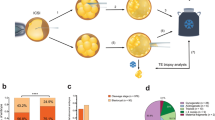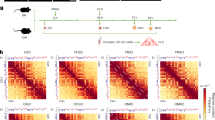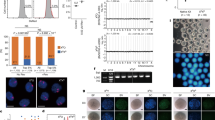Abstract
Aneuploidy has been a major issue in human gametes and is closely related to fertility problems, as it is known to be present in cleavage stage embryos and gestational losses. Pre-meiotic chromosome abnormalities in women have been previously described. The aim of this study is to assess the whole-chromosome complement in immature oocytes to find those abnormalities caused by mitotic instability. For this purpose, a total of 157 oocytes at the germinal vesicle or metaphase I stage, and discarded from IVF cycles, were analysed by CGH. Fifty-six women, between 18 and 45 years old (mean 32.5 years), including 32 IVF patients (25–45 years of age) and 24 IVF oocyte donors (18–33 years of age), were included in the study. A total of 25/157 (15.9%) of the oocytes analysed, obtained from three IVF clinics, contained chromosome abnormalities, including both aneuploidy (24/157) and structural aberrations (9/157). Independently of the maternal age, the incidence of abnormal oocytes which originated before meiosis is 15.9%, and these imbalances were found in 33.9% of the females studied. This work sheds light on the relevance of mitotic instability responsible for the generation of the abnormalities present in human oocytes.
Similar content being viewed by others
Log in or create a free account to read this content
Gain free access to this article, as well as selected content from this journal and more on nature.com
or
References
Hassold T, Hunt P : Maternal age and chromosomally abnormal pregnancies: what we know and what we wish we knew. Curr Opin Pediatr 2009; 21: 703–708.
Delhanty JD : Inherited aneuploidy: germline mosaicism. Cytogenet Genome Res 2011; 133: 136–140.
Angell RR : Predivision in human oocytes at meiosis I: a mechanism for trisomy formation in man. Hum Genet 1991; 86: 383–387.
Pellestor F, Andreo B, Arnal F, Humeau C, Demaille J : Mechanisms of non-disjunction in human female meiosis: the co-existence of two modes of malsegregation evidenced by the karyotyping of 1397 in-vitro unfertilized oocytes. Hum Reprod 2002; 17: 2134–2145.
Pujol A, Boiso I, Benet J et al: Analysis of nine chromosome probes in first polar bodies and metaphase II oocytes for the detection of aneuploidies. Eur J Hum Genet 2003; 11: 325–336.
Marquez C, Cohen J, Munne S : Chromosome identification in human oocytes and polar bodies by spectral karyotyping. Cytogenet Cell Genet 1998; 81: 254–258.
Sandalinas M, Marquez C, Munne S : Spectral karyotyping of fresh, non-inseminated oocytes. Mol Hum Reprod 2002; 8: 580–585.
Fragouli E, Escalona A, Gutierrez-Mateo C et al: Comparative genomic hybridization of oocytes and first polar bodies from young donors. Reprod Biomed Online 2009; 19: 228–237.
Sher G, Keskintepe L, Keskintepe M et al: Oocyte karyotyping by comparative genomic hybridization (correction of hybrydization) provides a highly reliable method for selecting ‘competent’ embryos, markedly improving in vitro fertilization outcome: a multiphase study. Fertil Steril 2007; 87: 1033–1040.
Geraedts J, Montag M, Magli MC et al: Polar body array CGH for prediction of the status of the corresponding oocyte. Part I: clinical results. Hum Reprod 2011; 26: 3173–3180.
Cozzi J, Conn CM, Harper J et al: A trisomic germ cell line and precocious chromatid segregation leads to recurrent trisomy 21 conception. Hum Genet 1999; 104: 23–28.
Mahmood R, Brierley CH, Faed MJ, Mills JA, Delhanty JD : Mechanisms of maternal aneuploidy: FISH analysis of oocytes and polar bodies in patients undergoing assisted conception. Hum Genet 2000; 106: 620–626.
Gutierrez-Mateo C, Wells D, Benet J et al: Reliability of comparative genomic hybridization to detect chromosome abnormalities in first polar bodies and metaphase II oocytes. Hum Reprod 2004; 19: 2118–2125.
Gutierrez-Mateo C, Benet J, Wells D et al: Aneuploidy study of human oocytes first polar body comparative genomic hybridization and metaphase II fluorescence in situ hybridization analysis. Hum Reprod 2004; 19: 2859–2868.
Gutierrez-Mateo C, Benet J, Starke H et al: Karyotyping of human oocytes by cenM-FISH, a new 24-colour centromere-specific technique. Hum Reprod 2005; 20: 3395–3401.
Fragouli E, Wells D, Thornhill A et al: Comparative genomic hybridization analysis of human oocytes and polar bodies. Hum Reprod 2006; 21: 2319–2328.
Fragouli E, Wells D, Whalley KM, Mills JA, Faed MJ, Delhanty JD : Increased susceptibility to maternal aneuploidy demonstrated by comparative genomic hybridization analysis of human MII oocytes and first polar bodies. Cytogenet Genome Res 2006; 114: 30–38.
Obradors A, Rius M, Cuzzi J et al: Errors at mitotic segregation early in oogenesis and at first meiotic division in oocytes from donor females: comparative genomic hybridization analyses in metaphase II oocytes and their first polar body. Fertil Steril 2010; 93: 675–679.
Delhanty JD : Mechanisms of aneuploidy induction in human oogenesis and early embryogenesis. Cytogenet Genome Res 2005; 111: 237–244.
Hulten MA, Patel SD, Tankimanova M et al: On the origin of trisomy 21 Down syndrome. Mol Cytogenet 2008; 1: 21.
Fragouli E, Alfarawati S, Goodall NN, Sanchez-Garcia JF, Colls P, Wells D : The cytogenetics of polar bodies: insights into female meiosis and the diagnosis of aneuploidy. Mol Hum Reprod 2011; 17: 286–295.
Rius M, Obradors A, Daina G et al: Reliability of short comparative genomic hybridization in fibroblasts and blastomeres for a comprehensive aneuploidy screening: first clinical application. Hum Reprod 2010; 25: 1824–1835.
Voullaire L, Slater H, Williamson R, Wilton L : Chromosome analysis of blastomeres from human embryos by using comparative genomic hybridization. Hum Genet 2000; 106: 210–217.
Cupisti S, Conn CM, Fragouli E et al: Sequential FISH analysis of oocytes and polar bodies reveals aneuploidy mechanisms. Prenat Diagn 2003; 23: 663–668.
Pellestor F, Andreo B, Arnal F, Humeau C, Demaille J : Maternal aging and chromosomal abnormalities: new data drawn from in vitro unfertilized human oocytes. Hum Genet 2003; 112: 195–203.
Tease C, Hartshorne GM, Hulten MA : Patterns of meiotic recombination in human fetal oocytes. Am J Hum Genet 2002; 70: 1469–1479.
Nicolaidis P, Petersen MB : Origin and mechanisms of non-disjunction in human autosomal trisomies. Hum Reprod 1998; 13: 313–319.
Wolstenholme J, Angell RR : Maternal age and trisomy—a unifying mechanism of formation. Chromosoma 2000; 109: 435–438.
Robles P, Roig I, Garcia R et al: Pairing and synapsis in oocytes from female fetuses with euploid and aneuploid chromosome complements. Reproduction 2007; 133: 899–907.
Weghofer A, Munne S, Brannath W et al: The impact of LH-containing gonadotropins on diploidy rates in preimplantation embryos: long protocol stimulation. Hum Reprod 2008; 23: 499–503.
Weghofer A, Munne S, Brannath W et al: The impact of LH-containing gonadotropin stimulation on euploidy rates in preimplantation embryos: antagonist cycles. Fertil Steril 2009; 92: 937–942.
Obradors A, Rius M, Daina G, Ramos L, Benet J, Navarro J : Whole-chromosome aneuploidy analysis in human oocytes: focus on comparative genomic hybridization. Cytogenet Genome Res 2011; 133: 119–126.
Hulten MA, Patel S, Jonasson J, Iwarsson E : On the origin of the maternal age effect in trisomy 21 Down syndrome: the Oocyte Mosaicism Selection model. Reproduction 2010; 139: 1–9.
Handyside AH, Montag M, Magli MC et al: Multiple meiotic errors caused by predivision of chromatids in women of advanced maternal age undergoing in vitro fertilisation. Eur J Hum Genet 2012; 20: 742–747.
Voet T, Vanneste E, Van der Aa N et al: Breakage-fusion-bridge cycles leading to inv dup del occur in human cleavage stage embryos. Hum Mutat 2011; 32: 783–793.
Voet T, Vanneste E, Vermeesch JR : The human cleavage stage embryo is a cradle of chromosomal rearrangements. Cytogenet Genome Res 2011; 133: 160–168.
Mrasek K, Schoder C, Teichmann AC et al: Global screening and extended nomenclature for 230 aphidicolin-inducible fragile sites, including 61 yet unreported ones. Int J Oncol 2010; 36: 929–940.
Franchitto A, Pichierri P : Understanding the molecular basis of common fragile sites instability: role of the proteins involved in the recovery of stalled replication forks. Cell Cycle 2011; 10: 4039–4046.
Hassold T, Hunt P : To err (meiotically) is human: the genesis of human aneuploidy. Nat Rev Genet 2001; 2: 280–291.
Vogt E, Kirsch-Volders M, Parry J, Eichenlaub-Ritter U : Spindle formation, chromosome segregation and the spindle checkpoint in mammalian oocytes and susceptibility to meiotic error. Mutat Res 2008; 651: 14–29.
Wang WH, Sun QY : Meiotic spindle, spindle checkpoint and embryonic aneuploidy. Front Biosci 2006; 11: 620–636.
Acknowledgements
This study was funded by grants from the Fondo de Investigaciones Sanitarias, Instituto de Salud Carlos III (PI 08/0012, PI 11/00625), Grup de Suport a la Recerca of the Generalitat de Catalunya (2009SGR1107) and Càtedra de Recerca Eugin-UAB. The first author had a pre-doctoral grant from Fundació Crèdit Andorrà (2008–2011).
Author information
Authors and Affiliations
Corresponding author
Ethics declarations
Competing interests
The authors declare no conflict of interest.
Additional information
Supplementary Information accompanies this paper on European Journal of Human Genetics website
Rights and permissions
About this article
Cite this article
Daina, G., Ramos, L., Rius, M. et al. Non-meiotic chromosome instability in human immature oocytes. Eur J Hum Genet 22, 202–207 (2014). https://doi.org/10.1038/ejhg.2013.106
Received:
Revised:
Accepted:
Published:
Issue date:
DOI: https://doi.org/10.1038/ejhg.2013.106
Keywords
This article is cited by
-
How common is germinal mosaicism that leads to premeiotic aneuploidy in the female?
Journal of Assisted Reproduction and Genetics (2019)



